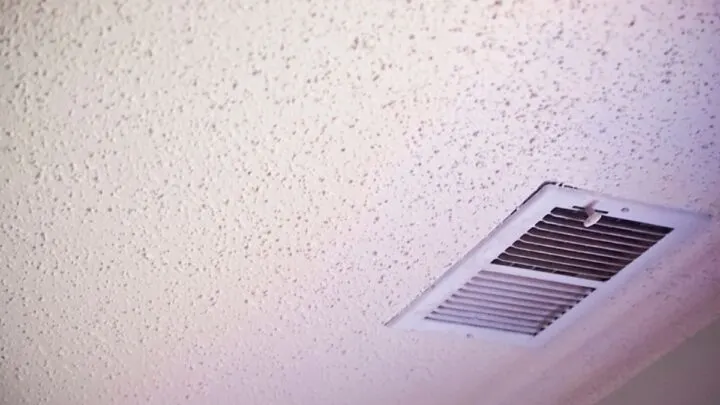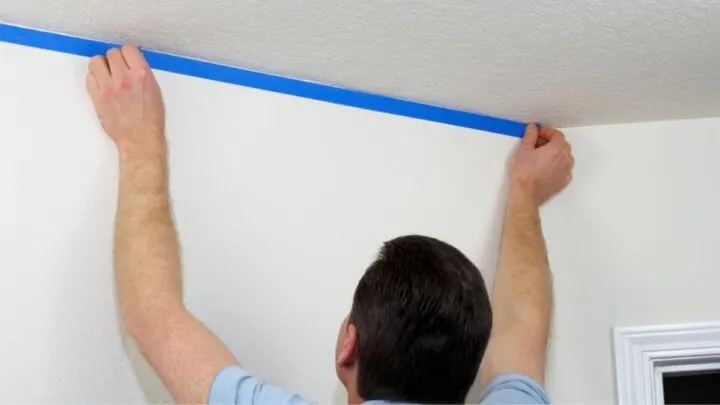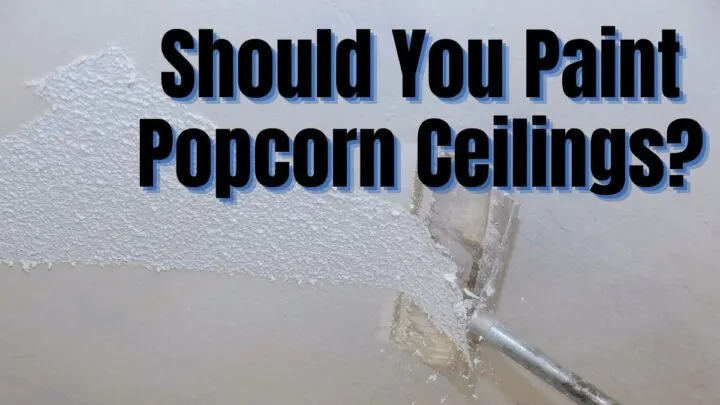Hands down, painting is one of the most fun home improvement activities. Since there are no power tools or sharp objects involved, little kids can help with painting.
Many parents even let their children paint on the walls and then go over any patchy spots when the kids are asleep.
Painting a wall or the ceiling is straightforward, but can you paint a popcorn ceiling?
You can paint over popcorn ceilings, as even a popcorn ceiling will need a fresh coat every couple of years. Using a paint sprayer is easiest, but if you only have a roller available, make sure you account for the texture of the ceiling as you paint.
Painting a popcorn ceiling can be as fun as painting a regular ceiling.
You’ll just need a bit more patience. And when you’re painting a ceiling, make sure you’re prepared for paint or debris to fall onto your face!
Should You Paint a Popcorn Ceiling?
So, you are looking around your home and you have decided that you want to repaint the walls and ceilings inside your home.
Perhaps it is a new year and you’ve been looking forward to redoing your home for a while.
Or maybe you finally found your perfect aesthetic look and you just can’t wait to get started.
But you have a problem! Instead of regular flat ceilings, you have popcorn or stucco ceilings in your living room, hallway, and bedrooms.
Usually, you don’t have to think about your ceiling’s paint.
But you can plainly tell that the paint on the popcorn ceiling is getting old. There may even be paint chipping away in the corners.
What should you do? Did you have a contractor remove the popcorn ceiling? Or is it possible to paint a popcorn ceiling?
If your sudden home decoration surge has come to a halt because you don’t know what to do about popcorn ceilings, we have the answer for you.
You can and should paint over a popcorn ceiling. There is no need to remove the popcorn or neglect painting the popcorn ceiling.
Popcorn ceilings are a common type of ceiling in North America.
Contractors often put in popcorn ceilings because the texture of the ceiling absorbs sound and reduces echo.

What Tools Do I Need?
There are no specialized tools you will need to purchase for painting a popcorn ceiling.
All the equipment you will need to paint a stucco or popcorn ceiling will be the same as a regular flat ceiling. However, if you do have a paint sprayer, it makes the job go by much more quickly.
The only change you might encounter is more tarp or coverings. Instead of just covering the furniture, the entire floor will need to be covered.
- Tarps and covers.
- Paint brush and roller brush.
- A painting tray.
- Painter’s tape: Unless you plan to paint the popcorn ceiling and the walls of the room with the same color, you will need painter’s tape.
- Hair cover: When painting a ceiling, small flecks of paint will fall from the ceiling. You can use any type of hair cover, like a grocery bag or a shower cap. If you use a hat, use a hat that you dislike and won’t care if it gets paint on it.
- Safety goggles: An extension pole which attaches to the rolling brush should make it very easy to reach the ceiling. If you struggle to reach the ceiling even with using a pole, you may need to get on a ladder.
- A flashlight: Even if you are painting during the daytime, extra light will help you see any patches on the popcorn ceiling where there is not enough paint.
- Ladder: We would rather you use an extension pole than get on a ladder. But if you don’t have an extension pole, then you will need a ladder. Do not use a step stool. It would be better to use a full-length ladder.
Type of Paint Needed
Popcorn ceilings do not require a specialized paint. You can use the same type of paint as you would a regular ceiling or the walls of the room.
But there are certain types of paint that will look terrible on a popcorn ceiling.
Most home decorators recommend only using flat or non-high gloss paint on a popcorn ceiling.
You don’t want any type of paint that will cause the popcorn texture to stand out when the light in the room is on.
The texture will also stand out if the sun is shining through a window and there is high gloss paint on the ceiling.
It is up to you whether you want to apply primer. If you can find a flat paint that already has a primer inside it, that is fine as well. Just be careful not to use a shiny or high gloss primer.
How to Paint a Popcorn Ceiling
Now that we have all of our tools, it’s time to get to work.
Here are the steps you can follow to ensure a beautiful painted popcorn ceiling.
Step 1: Dust and Wash the Ceiling
Just like any other painting job, the room must be prepped, and the ceiling must be washed. Remove all hanging decorations.
Then, look over the ceiling and check it over for any patches of mold, cobwebs, dust, and general dirtiness.
Do not think about painting over the dust and mold.
Not only will the dust gather on your roller brush, but the mold can also regrow in the same spot and the cobwebs will stick to the ceiling.
When washing a popcorn ceiling, you cannot be as rough as with a regular flat ceiling.
You do not want all the small pieces of popcorn material to fall off.
Do not use a washcloth. It is better to use a soft thistle brush.
If you are painting the rest of the room as well, now is a suitable time to wash the walls and moulding.

Step 2: Line the Walls With Painters’ Tape
Do not put the tape on the ceiling. Place the tape as closely as possible to the indent where the wall meets the ceiling.
Wearing gloves is ideal during the lining of painter’s tape because you may cut yourself on the stucco texture if you are not careful.
The painter’s tape needs to go all around the room and over any crown molding, fixtures, or permanent decorations. However, you may not need painter’s tape if you plan to paint the walls and the ceiling with the same paint.
Step 3: Cover Everything With Plastic Sheeting or Coverings
No matter how careful you are, small splotches of paint will fall from the ceiling and land on whatever is below.
So be sure to spread any tarps and covers over the furniture. You also need to cover the entire floor.
If you have any shelves that you cannot remove from the wall, cover the shelves in Saran Wrap.
It is best to remove anything you can from the room you’ll be painting.
Step 4: Time to Paint
First, apply paint to the painter’s brush, climb the ladder, and slowly paint a protective line around the entire ceiling.
The paint should be close enough to touch the painter’s tape.
After painting a protective line around the edge of the ceiling, attach the rolling paintbrush to the extension pole and dip it in the paint tray.
Then roll off the excess and begin painting the ceiling.
Do not press down hard on the stucco ceiling, as it will cause the texture to break off and land on the floor.
Unless you’re painting the entire ceiling by hand with a regular paintbrush, there will be some breakage.
Slowly glide the brush back and forth. Make sure the paint on the roller brush or paint brush is thin so the paint does not gather up around the textured pieces.
Step 5: Allow Paint to Dry
As the paint dries, look for uneven patches of paint. Try using different lighting sources inside the room, like a flashlight, to find patches that need to be painted.
When it is nighttime, turn on the main light in the room. Once you find the patches, repaint the areas and allow them to dry.
Conclusion to Painting Stucco Ceilings
Yes, you should and can paint popcorn ceilings. You need to apply painter’s tape to the walls and cover the entire floor and all the furniture before you paint the ceiling.
Do not press down hard or the textured pieces will break off. Use a flat paint to paint a stucco ceiling.
You do not have to use a primer or use a flat paint that has primer.


